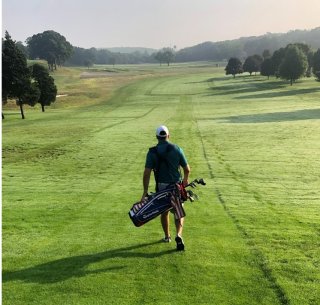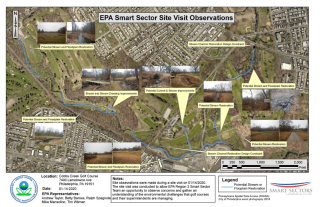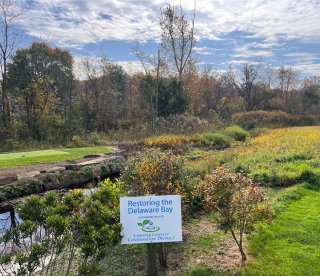Urban Golf and the Partnerships for Progress
“In West Philadelphia, born and raised. On the golf course was where I spent most of my days” …OK, so maybe the Fresh Prince never took up golf before being sent out to live with his auntie and uncle in Bel Air. But for today’s youth of West Philly, golf will soon start becoming a more accessible option. I am all for getting young people introduced to the game of golf, especially in historically underserved areas.
In many ways golf is more than just a game. Golf offers you the opportunity to spend time with people you care about, develop new skills, and continue to challenge yourself. Golf allows you to get out and spend time in greenspaces for hours at a time. After walking 18-holes, you may have even hit (or exceeded!) your step goal for the day.
There’s a special place, right down the street from our Region 3 office in Center City Philadelphia, that is reimaging how kids are introduced to golf and all of the ways that courses can be a welcoming greenspace.
The History of Cobbs Creek

Cobbs Creek Golf Course is a historic landmark with a storied past of breaking barriers and redefining what city public golf looks like. Opened in 1916 as one of the first integrated golf courses in the nation, Cobbs Creek welcomed women and people of color—a win for accessibility in a sport known for being historically exclusive. Charlie Sifford, who eventually broke the color barrier on the PGA Tour in 1961, called Cobbs Creek home.
However, after continued challenges with flooding and eventually falling into disrepair, the future of this 340-acre greenspace was unknown. In 2018, the Cobbs Creek Foundation was awarded the lease of the property with a grand plan to revamp and revitalize the campus. After years of planning, the renovation and restoration are set to be completed by then end of 2026, and Cobbs Creek will once again be a place for everyone.
The reimagined Cobbs Creek Campus will feature a state-of-the-art facility, housing a retail pro shop, driving range, restaurant and bar, and community event space. Though, even more notably, the campus will be home to the TGR Learning Lab, a 30,000 square-foot STEAM education center, sponsored by Tiger Woods’ TGR Foundation. Aiming to serve 4,500-plus local students per year, this education center will provide free year-round tutoring, after-school programming, and college access and career readiness programs.
Along with the facility upgrades, the project commits to a full restoration of the 18-hole “Olde Course”, development of a new 9-hole course, as well as a new TGR-designed “short” course aimed to help introduce the sport to participants of all ages and abilities.

Another major component of this project is to address the flooding that continually hindered the property’s landscape for years. The project seeks to provide long-term sustainability and flood-risk mitigation for the neighboring community through the restoration of three miles of Cobbs Creek, Indian Creek, and adjacent tributaries, as well as the addition of new green infrastructure and wetlands.
About EPA’s Smart Sectors Program
One way that we engage with industries such as golf and other outdoor recreation is through our “Smart Sectors” program. The Smart Sectors Program is a partnership program that provides an opportunity to build meaningful collaborations with industry sectors and develop creative solutions that better protect the environment and public health. The ongoing work at Cobbs Creek is a great example of how the golf industry has committed to environmental stewardship and sustainability, increasing accessibility to the game, and connecting with local communities to provide open greenspace access to everyone. Other sectors that we collaborate with include the agriculture, automotive, chemical manufacturing, and mining industries.
Heading in the Right Direction
In the fall of 2022, members of our U.S. EPA Region 3 Smart Sectors team attended the signing ceremony for a Memorandum of Understanding (MOU) with the Golf Course Superintendents Association of America (GCSAA). This MOU established a partnership between EPA and GCSAA to facilitate implementation of environmental/sustainability practices, increase access to open space and career opportunities in underserved communities, and work together on industry challenges in order to promote environmental stewardship.
While more progress is still to be made, superintendents have reduced water usage by nearly 30% since 2005 and have reduced fertilizer usage by over 40%. With our help through the Smart Sectors Program and partnerships like the GCSAA MOU, golf courses can continue to improve their daily practices, incorporate green infrastructure, and make surrounding communities more resilient in the face of climate change.

Some of my favorite examples of environmentally beneficial practices that are currently going on at courses across the country include the incorporation of native meadow habitat for pollinators, introducing beehives, planting riparian buffers around ponds and stream corridors, and creating rain gardens to capture and filter stormwater runoff near parking lots and clubhouses.
By partnering with industries and sectors, we are in a better position to help accelerate progress and deliver results to the communities who need it most. By engaging with these groups, we build relationships and get an opportunity to really know what is going on—what problems are currently faced, how decisions are being made, who is impacted by these decisions—all things that help gain perspective.
- To learn more about some of the environmental work currently being done by GCSAA and its members, visit GCSAA’s Environment Hub or check out the GCSAA’s environmental blog.
- To learn more about other organizations helping to move the game of golf forward in environmental stewardship, check out the GEO Foundation for Sustainable Golf and the Audubon Cooperative Sanctuary Program for Golf.
- Curious about another golf course renovation project that includes stream restoration and promotes access to community greenspace? Check out the National Links Trust and their work on Washington, D.C.’s municipal golf courses.

About the Author
Hunter Pates
Life Scientist
EPA Region 3
Hunter Pates is a Life Scientist in the Water Division of EPA’s Region 3. He works in the Standards and TMDLs Section as the Water Quality Standards and 303(d)/TMDL Coordinator for the state of Maryland. He became involved with the EPA’s Smart Sectors Program in the fall of 2023. Hunter holds an MS in Coastal Marine and Wetland Studies from Coastal Carolina University and a BS in Biology from Misericordia University. While he doesn’t have time to golf as much as he used to, he enjoys spending time with his wife and two young sons, drinking coffee, and doing home improvement projects.
Editor’s Note: The views expressed here are intended to explain EPA policy. They do not change anyone’s rights or obligations. You may share this article. However, please do not change the title or the content, or remove EPA’s identity as the author. If you do make substantive changes, please do not attribute the edited title or content to EPA or the author.
EPA’s official web site is www.epa.gov. Some links on this page may redirect users from the EPA website to specific content on a non-EPA, third-party site. In doing so, EPA is directing you only to the specific content referenced at the time of publication, not to any other content that may appear on the same webpage or elsewhere on the third-party site, or be added at a later date.
EPA is providing this link for informational purposes only. EPA cannot attest to the accuracy of non-EPA information provided by any third-party sites or any other linked site. EPA does not endorse any non-government websites, companies, internet applications or any policies or information expressed therein.
